Last updated: August 7, 2025
Article
Climate and Water Monitoring at Amistad National Recreation Area: Water Year 2021

NPS
Overview
Together, climate and hydrology shape ecosystems and the services they provide, particularly in arid and semi-arid ecosystems. Understanding changes in climate, groundwater, and surface water is key to assessing the condition of park natural resources—and often, cultural resources.
At Amistad National Recreation Area (NRA), Our Chihuahuan Desert Network scientists study how ecosystems may be changing by taking measurements of key resources or "vital signs" year after year, much as a doctor keeps track of a patient’s vital signs. This long-term ecological monitoring provides early warning of potential problems, allowing managers to mitigate them before they become worse. We monitor climate, weather, groundwater, reservoir level, and springs among other vital signs at the park.
Surface-water and groundwater conditions are closely related to climate conditions. Because they are better understood together, we report on climate in conjunction with water resources. Reporting is by water year (WY), which begins in October of the previous calendar year and goes through September of the water year (e.g., WY2021 runs October 2020 through September 2021). Information is added to this page as it becomes available throughout the year.

NPS
Climate and Weather
There is often confusion over the terms, "weather" and "climate." In short, weather describes instantaneous meteorological conditions (e.g., it's currently raining or snowing, it's a hot or frigid day). Climate reflects patterns of weather at a given place over longer periods of time (seasons to years). Climate is the primary driver of ecological processes on earth. Climate and weather information provide context for understanding the status or condition of other park resources.
Methods
Since 1964, Amistad NRA has operated a National Oceanic and Atmospheric Administration Cooperative Observer Program weather station (Amistad Dam #410225, Fig. 1). This station provides a reliable, long-term climate dataset used for analyses in this climate and water report. Data from this station are accessible through Climate Analyzer.

NPS
Recent Findings
Precipitation
Annual precipitation at the Amistad Dam station in WY2021 was 15.45″ (39.2 cm; Figure 2), 3.98″ (10.1 cm) less than the 1991–2020 normal. This precipitation deficit occurred primarily in the cool season (October–March). Rainfall in the warm season (April–September) was near normal. Extreme daily rainfall events (>1″; 2.54 cm) occurred on 4 days, one less than the normal annual frequency. Extreme rainfall events occurred on December 31, 2020 (1.31″; 3.3 cm); May 1, 2021 (2.00″; 5.1 cm); July 6, 2021 (1.70″; 4.3 cm); and August 18, 2021 (1.71″; 4.3 cm).
Air Temperature
Mean annual maximum air temperatures in WY2021 were 0.2°F (0.1°C) warmer than the normal 81.1°F (27.3°C), and mean annual minimum air temperatures were 1.0°F (0.6°C) cooler than the normal minimum of 58.0°F (14.4°C; normal is based on means from 1991–2020). Mean monthly maximum and minimum temperatures were generally near normal (Figure 2); however, large temperature deviations were observed in November, which was substantially warmer than normal, and February, which was substantially cooler than normal. No days recorded extremely hot temperatures (>102°F; 38.8°C) in WY2021 compared to the normal frequency (21.8 days). Extremely cold temperatures (<35°F;1.7°C) occurred on 30 days, almost twice the normal frequency (16.6 days).

NPS
Drought
Reconnaissance drought index provides a measure of drought severity and extent relative to the long-term climate. It is based on the ratio of average precipitation to average potential evapotranspiration (water loss due to evaporation and plant transpiration) over short periods of time (seasons to years). The reconnaissance drought index for Amistad NRA indicates WY2021 was a slightly drier year from the perspective of both precipitation and evaporative demand (amount of water evaporated; Figure 3).

NPS
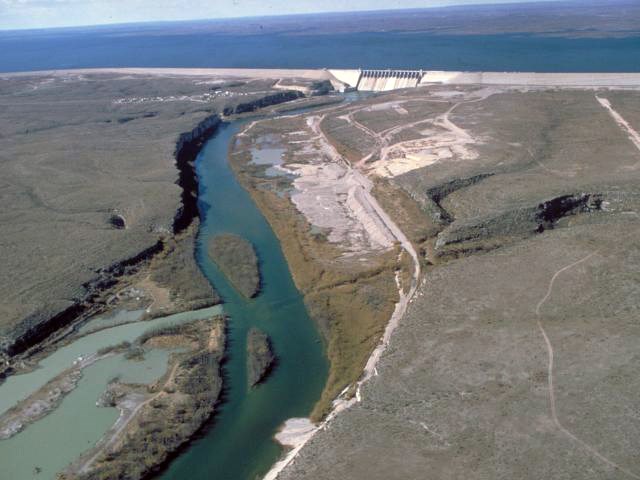
NPS
Reservoir Level
The Amistad International Reservoir was formed by the construction of Amistad Dam between 1964 and 1969. Reservoir level is not a Chihuahuan Desert Network vital sign; however, it is included in this report because the reservoir level has implications for park resources throughout Amistad NRA, including groundwater and springs.
MethodsThe International Boundary and Water Commission (IBWC) has operated a water level gage at Amistad Reservoir (International Amistad Reservoir Storage Station Number 08-4508.00) since 1968 when filling began. The gage is located at the downstream end of the reservoir. Every 15 minutes, the gage collects water level data, which are available from the IBWC and the Texas Water Development Board (TWDB).
Recent FindingsMean reservoir level in WY2021 was 1068.24 feet above mean sea level (amsl) with a range of 1066.90 to 1073.76 feet amsl. Daily water level in WY2021 was on average 21.49 feet below the mean for 1991–2020 (Figure 4). The reservoir ranged from 51.2–65.3% full.

NPS
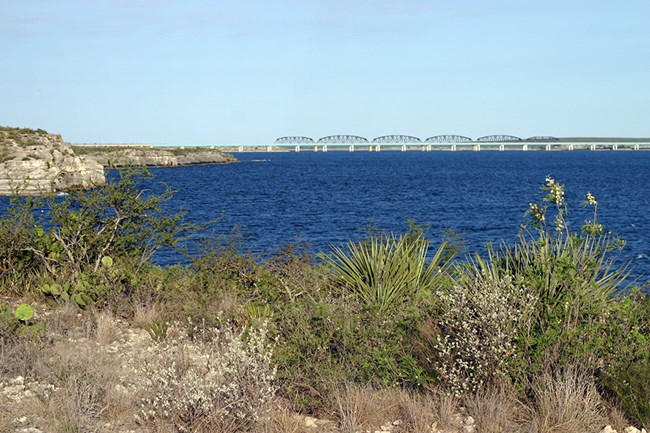
NPS
Groundwater
Groundwater is one of the most critical natural resources of the American Southwest, providing drinking water, irrigating crops, and sustaining rivers, streams, and springs throughout the region.
MethodsAmistad NRA groundwater is monitored using six wells in or near the recreation area (Figure 1). Each well is monitored annually by the Texas Water Development Board (TWDB) and the data are available at the Texas Water Development Board Groundwater Database.
Recent Findings
Groundwater at the park was not monitored by TWDB in WY2021 due to Covid-19 disruptions to fieldwork. The most recent results are from February 25–27, 2020. Groundwater levels in the six monitored wells decreased between WY2019 and in WY2020 (Figure 5 and Table 1). These decreases were consistent with a 7.93-foot decline in reservoir level over the same period. Groundwater levels in wells 7033302, 7033508, 714021, and 7140307 are on the periphery of the reservoir and were ≤ 10.78 feet below the level of the reservoir. Water levels in wells 7017403 and 7140307 were both substantially higher than the reservoir level. They demonstrated a muted response to reservoir level because they are up gradient of the reservoir, adjacent to the Devils River and the Pecos River, respectively.

NPS
Table 1. Groundwater monitoring results in water year 2020, Amistad National Recreation Area (amsl = above mean sea level; bgs = below ground surface).
| State Well Number | Location | Wellhead Elevation (ft amsl) | Depth to Water (ft bgs) | Water Level Elevation (ft amsl) | Change in Elevation from Water Year 2019 (± ft) | Elevation Difference From Amistad Reservoir Level (± ft) |
|---|---|---|---|---|---|---|
| 7017403 | 15.6 miles NNE of dam on Devil's River | 1180 | 62.12 | 1117.88 | -0.56 | +32.73 |
| 7033302 | 9.2 miles ENE of dam | 1215 | 135.54 | 1079.46 | -7.93 | -5.77 |
| 7033508 | 6.7 miles E of dam | 1175 | 128.07 | 1046.93 | -6.14 | -3.83 |
| 7122403 | 25.3 miles NW of dam on Pecos River | 1312 | 162.60 | 1149.40 | -2.99 | +64.23 |
| 7140201 | 3.2 miles NNE of dam | 1167 | 92.1 | 1074.9 | -10.86 | -10.33 |
| 7140307 | 2.0 miles NE of dam | 1162 | 87.55 | 1074.45 | -7.98 | -10.78 |
Springs
Background
Springs, seeps, and tinajas (small pools in a rock basin or impoundments in bedrock) are small, relatively rare biodiversity hotspots in arid lands. They are the primary connection between groundwater and surface water and are important water sources for plants and animals. For springs, the most important questions we ask are about persistence (How long was there water in the spring?) and water quantity (How much water was in the spring?).
Methods
Chihuahuan Desert Network springs monitoring is organized into four modules, described below.Site Characterization Module: This module includes GPS locations and a site diagram and provides context for interpreting change in the other modules. We also describe the spring type (e.g., heleocrene, limnocrene, rheocrene, or tinaja) and its associated vegetation. Helocrene springs emerge as low-gradient wetlands, limnocrene springs emerge as pools, and rheocrene springs emerge as flowing streams. This module is completed once every five years or after significant events.
Site Condition Module: We estimate natural and anthropogenic disturbances and the level of stress on vegetation and soils on a scale of 1–4, where 1 = undisturbed, 2 = slightly disturbed, 3 = moderately disturbed, and 4 = highly disturbed. Types of natural disturbances can include flooding, drying, fire, wildlife impacts, windthrow of trees and shrubs, beaver activity, and insect infestations. Anthropogenic disturbances can include roads and off-highway vehicle trails, hiking trails, livestock and feral animal impacts, removal of invasive non-native plants, flow modification, and evidence of human use. We take repeat photographs that show the spring and its landscape context. We record the density of invasive, non-native plants and note the presence of certain obligate wetland plants (plants that almost always occur only in wetlands), facultative wetland plants (plants that usually occur in wetlands, but also occur in other habitats), and non-native bullfrogs and native crayfish.
Water Quantity Module: We measure the persistence of surface water, amount of spring discharge, and wetted extent. To estimate persistence, we analyze the variance of temperature measurements taken by logging thermometers placed at or near the orifice (spring opening) or in a tinaja. Because water mediates variation in diurnal temperatures, data from a submerged sensor will show less daily variation than data from an exposed sensor, and this tells us when the spring was wet or dry. Surface discharge is measured with a timed sample of water volume. Wetted extent is a systematic measurement of the physical length (up to 100 m), width, and depth of surface water. It is assessed using a technique for either standing water (e.g., limnocrene and heleocrene springs and some tinajas; in the largest pool) or flowing water (e.g., rheocrene springs and some tinajas).
Water Quality Module: We measure core water quality parameters and water chemistry. Core parameters include water temperature, pH, specific conductivity (a measure of dissolved compounds and contaminants), dissolved oxygen (how much oxygen is present in the water), and total dissolved solids (an indicator of potentially undesirable compounds). Discrete samples of these parameters are collected with a multiparameter meter. If the meter failed calibration checks, we do not present data. Water chemistry is assessed by collecting surface water sample(s) and estimating the concentration of major ions with a photometer in the field. These parameters are collected at one or more sampling locations within a spring but here we present information only from the primary sampling location.
More details on methods are available in the Chihuahuan Desert Network's springs monitoring protocol.
Click on a spring below to view monitoring results.
Big Satan Canyon SpringDead Mans Canyon Spring
Indian Springs Canyon Spring
Mouth of the Pecos

NPS
Recent Findings at Big Satan Canyon Spring
Big Satan Canyon Spring was last characterized in WY2018. Big Satan Canyon Spring was classified as a rheocrene spring (a spring that emerges as a flowing stream). This spring was a complex of six individual spring orifices. Cool and clear water flowed through a series of cracks and variable channels that ran a short distance and emptied into the adjacent Amistad Reservoir.
Site Condition
There was moderate disturbance from hiking trails. This is the first year that we noted trails to the spring. We noted slight disturbance from contemporary human use, drying, and wildlife (non-livestock), similar to past ratings. No crayfish or bullfrogs were observed.
The crew observed the following obligate/facultative wetland species/genera/families: bluestem (Andropogon sp.), fogfruit (Phyla sp.), mule-fat (Baccharis salicifolia), rush family (Juncaceae family), sedge family (Cyperaceae family), and spikerush (Eleocharis sp.). This was the first observation of mule-fat at the spring.
The crew observed two invasive plant species: yellow bluestem (Bothriochloa ischaemum) in evenly distributed patches and 1–5 tree tobacco (Nicotiana glauca) plants. There was a higher density of yellow bluestem than in previous years.
Water Quantity
The WY2021 visit occurred on April 14, 2021. Temperature sensors are not deployed at the site due to potential loss due to flooding and lake inundation. Discharge and wetted extent (a measure of length, width, and depth of surface water) were measured in prior years (Tables 2 and 3), but were not measured in WY2021 because the orifices were barely wetted (contained water).
Water Quality
Core water quality data were collected at two sampling locations in WY2021. Compared to previous years, dissolved oxygen was higher, and total dissolved solids and specific conductivity were slightly higher (Table 4). Water chemistry data were collected at one of the sampling locations in WY2021. Chloride levels were higher than in previous years, whereas other parameters were similar to WY2017–2018 samples (Table 5).
Big Satan Canyon Spring Data Tables
| Sampling Location (Orifice) | Water Year 2021 | Prior Water Years When Discharge Was Measured |
Range of Values From Prior Years |
|---|---|---|---|
| 002 | c.n.s. | 2017 | 12.1 (1) |
| Measurement | Water Year 2021 | Prior Water Years When Extent Was Measured |
Range of Values From Prior Years |
|---|---|---|---|
| Width (cm) | c.n.s. | 2018 | 1140 (1) |
| Depth (cm) | c.n.s. | 2018 | c.n.s. |
| Length (cm) | c.n.s. | 2018 | 3250 (1) |
| Sampling Location |
Width/Depth | Parameter | Water Year 2021 |
Prior Years When Sampling Occurred (Range) |
Range of Values From Prior Years |
|---|---|---|---|---|---|
| 001 | Center | Dissolved oxygen (mg/L) | 6.17 | 2018–2019 | 4.64–4.82 (2) |
| Center | pH | 7.31 | 2017–2019 | 7.37–7.54 (3) | |
| Center | Specific conductivity (µS/cm) | 471.0 | 2018–2019 | 422.2–434.4 (2) | |
| Center | Temperature (°C) | 23.1 | 2017–2019 | 21.9–23.4 (5) | |
| Center | Total Dissolved Solids (mg/L) | 306.0 | 2017–2019 | 274.3–303.6 (3) |
| Sampling Location | Width/Depth | Parameter | Water Year 2021 |
Prior Years When Sampling Occurred (Range) |
Range of Values From Prior Years |
|---|---|---|---|---|---|
| 001 | Center | Alkalinity (CaCO3) | 185 | 2017–2018 | 215–245 (2) |
| Center | Calcium (Ca) | 58 | 2017–2018 | 62–64 (2) | |
| Center | Chloride (Cl) | 87 | 2017–2018 | 9–11 (2) | |
| Center | Magnesium (Mg) | 10 | 2017–2018 | 13–15 (2) | |
| Center | Potassium (K) | 0.9 | 2017–2018 | 1.4–1.6 (2) | |
| Center | Sulphate (SO4) | 0.0 | 2017–2018 | 2–5 (2) |
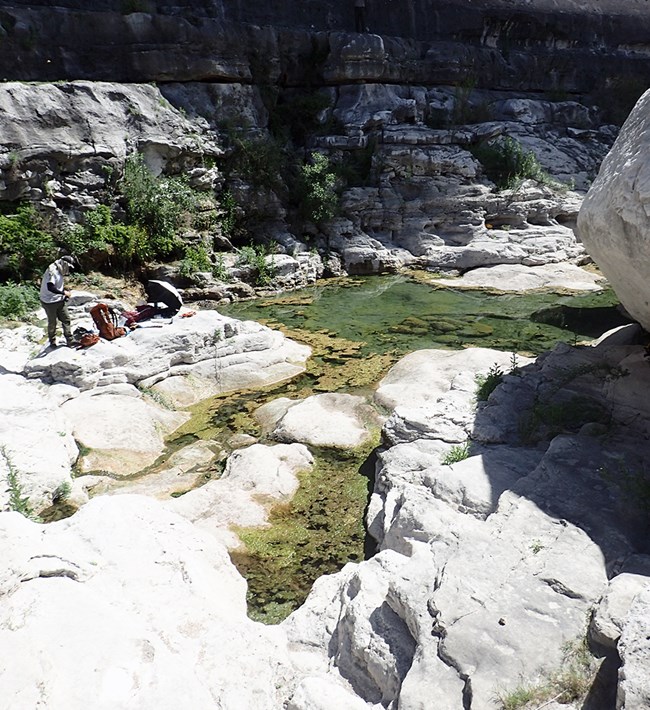
NPS
Recent Findings at Dead Mans Canyon Spring
Dead Mans Canyon Spring was last characterized in WY2018. This spring was classified as a rheocrene system, a spring that emerges as a flowing stream. It was also a hanging garden—a type of spring that emerges horizontally from a vertical surface or slope and creates a spring-fed plant colony that appears as a hanging garden. The water emerged several meters above the reservoir and the spring was about 25 m wide (82 ft) with 6 orifices. Cool and clear water flowed from the orifices (only one was not flowing) and algae was present in the pools.
Site Condition
The spring was not visited during WY2021.

NPS
Water Quantity
Temperature sensors have not been retrieved since April 2019. The site was inaccessible due to low lake levels in WY2021 and site visits were cancelled in WY2020 due to COVID. Persistence data (whether the spring was wet or dry) are shown for prior years in Figure 6. A range of discharge and wetted extent data from prior years are shown in Tables 6 and 7.
Water Quality
The spring was not visited during WY2021. See Tables 8 and 9 for water quality value ranges from prior years.
Dead Mans Canyon Spring Data Tables
| Sampling Location | Water Year 2021 |
Prior Water Years When Discharge Was Measured |
Range of Values From Prior Years |
|---|---|---|---|
| 007 | c.n.s. | 2017–2019 | 6.7–14 (3) |
| Measurement | Water Year 2021 |
Prior Water Years When Springs Were Measured |
Range of Values From Prior Years |
|---|---|---|---|
| Width (cm) | c.n.s. | 2018–2019 | 92.9–93.0 (2) |
| Depth (cm) | c.n.s. | 2018–2019 | 5.2–5.8 (2) |
| Length (m) | c.n.s. | 2018–2019 | 6.7–7.0 (2) |
| Sampling Location |
Width/Depth | Parameter | Water Year 2021 |
Prior Years When Sampling Occurred |
Range of Values From Prior Years |
|---|---|---|---|---|---|
| 001 | 25%/Center | Dissolved oxygen (mg/L) | c.n.s. | 2019 | 8.27 (1) |
| 50%/Center | Dissolved oxygen (mg/L) | c.n.s. | 2019 | 8.33 (1) | |
| 75%/Center | Dissolved oxygen (mg/L) | c.n.s. | 2019 | 8.29 (1) | |
| Center | Dissolved oxygen (mg/L) | c.n.s. | 2017–2018 | 5.59–12.02 (2) | |
| 25%/Center | pH | c.n.s. | 2019 | 8.16 (1) | |
| 50%/Center | pH | c.n.s. | 2019 | 8.15 (1) | |
| 75%/Center | pH | c.n.s. | 2019 | 8.14 (1) | |
| Center | pH | c.n.s. | 2017–2018 | 8.01–8.18 (2) | |
| 25%/Center | Specific conductivity (µS/cm) | c.n.s. | 2019 | 444.9 (1) | |
| 50%/Center | Specific conductivity (µS/cm) | c.n.s. | 2019 | 442.3 (1) | |
| 75%/Center | Specific conductivity (µS/cm) | c.n.s. | 2019 | 443.2 (1) | |
| Center | Specific conductivity (µS/cm) | c.n.s. | 2018 | 424.6 (1) | |
| 25%/Center | Temperature (°C) | c.n.s. | 2019 | 21.2–21.7 (2) | |
| 50%/Center | Temperature (°C) | c.n.s. | 2019 | 21.6–21.7 (2) | |
| 75%/Center | Temperature (°C) | c.n.s. | 2019 | 21.9–22.0 (2) | |
| Center | Temperature (°C) | c.n.s. | 2017–2018 | 21.3–22.3 (3) | |
| 25%/Center | Total Dissolved Solids (mg/L) | c.n.s. | 2019 | 289.2 (1) | |
| 50%/Center | Total Dissolved Solids (mg/L) | c.n.s. | 2019 | 287.3 (1) | |
| 75%/Center | Total Dissolved Solids (mg/L) | c.n.s. | 2019 | 288.0 (1) | |
| Center | Total Dissolved Solids (mg/L) | c.n.s. | 2017–2018 | 271.0–275.6 (2) |
| Sampling Location | Width/Depth | Parameter | Water Year 2021 |
Prior Years When Sampling Occurred |
Range of Values From Prior Years |
|---|---|---|---|---|---|
| 001 | Center | Alkalinity (CaCO3) | c.n.s. | 2017–2019 | 180–190 (3) |
| Center | Calcium (Ca) | c.n.s. | 2017–2019 | 58–70 (3) | |
| Center | Chloride (Cl) | c.n.s. | 2017–2019 | 13–14 (3) | |
| Center | Magnesium (Mg) | c.n.s. | 2017–2019 | 12–96 (3) | |
| Center | Potassium (K) | c.n.s. | 2017–2019 | 0.8–1.7 (3) | |
| Center | Sulphate (SO4) | c.n.s. | 2017–2019 | 3–8 (3) |
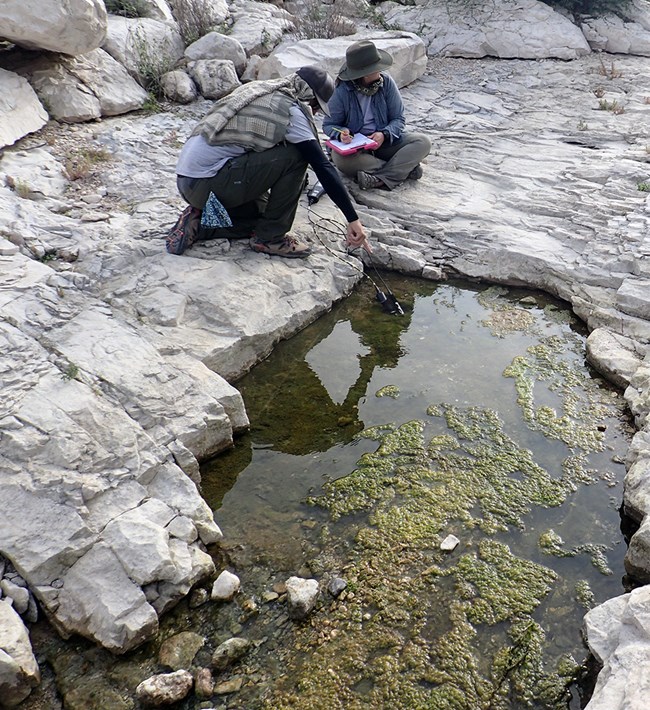
NPS
Recent Findings at Indian Springs Canyon Spring
Indian Springs Canyon Spring was last characterized in WY2018. This spring was classified as a rheocrene spring, a spring that flows into a stream. Water flowed clear and cool from a single orifice into a small pool and eventually into the Amistad Reservoir. There was a thick algal mat present on the surface of much of the pool and submerged algae was found throughout.
Site Condition
There was moderate disturbance from feral animals and high disturbance from drying. Disturbance from feral animals has been observed previously but this is the first indication of disturbance that was attributable to drying. However, during the 2022 visit park staff stated that the emergence point may shift depending on lake levels; only a single potential emergence point was assessed in 2021. No crayfish or bullfrogs were observed.
The crew observed a single obligate/facultative wetland plant: fogfruit (Phyla sp.). This genus was also observed in WY2019.
The crew observed scattered patches of two invasive plants species: yellow bluestem (Bothriochloa ischaemum) and lilac chastetree (Vitex agnus-castus). We observed similar densities of both species in prior years.

NPS
Water Quantity
On the WY2021 visit (April 13, 2021), discharge and wetted extent were not measured because the spring was dry. However, during the 2022 visit, park staff said the emergence point may shift depending on lake levels; only a single potential emergence point was assessed in 2021. Tables 10–11 show prior year ranges of values for discharge and wetted extent. Temperature sensors indicated that the spring was wetted for 10 of 195 days (5.1%)—measured up to the WY2021 visit (Figure 7). In prior water years, the spring was wetted 15.8–86.8% of the days measured.
Water Quality
Water quality was not measured because the spring was dry. See Tables 12 and 13 for water quality value ranges from prior years.
Indian Springs Canyon Spring Data Tables
| Sampling Location | Water Year 2021 |
Prior Water Years When Discharge Was Measured |
Range of Values From Prior Years |
|---|---|---|---|
| 002 | c.n.s. | 2018 | 86.5 (1) |
| Measurement | Water Year 2021 |
Prior Water Years When Springs Were Measured |
Range of Values From Prior Years |
|---|---|---|---|
| Width (cm) | c.n.s. | 2017–2019 | 179.2–293.1 (3) |
| Depth (cm) | c.n.s. | 2017–2019 | 3.5–13.7 (3) |
| Length (cm) | c.n.s. | 2017–2019 | 27–100 (3) |
| Sampling Location |
Width/Depth | Parameter | Water Year 2021 |
Prior Years When Sampling Occurred |
Range of Values From Prior Years |
|---|---|---|---|---|---|
| 001 | 25%/Center | Dissolved oxygen (mg/L) | c.n.s. | 2019 | 8.06 (1) |
| 50%/Center | Dissolved oxygen (mg/L) | c.n.s. | 2019 | 7.49 (1) | |
| 75%/CenterCenter | Dissolved oxygen (mg/L) | c.n.s. | 2019 | 7.20 (1) | |
| Center | Dissolved oxygen (mg/L) | c.n.s. | 2017–2018 | 6.70–7.29 (4) | |
| 25%/Center | pH | c.n.s. | 2019 | 7.16 (1) | |
| 50%/Center | pH | c.n.s. | 2019 | 7.58 (1) | |
| 75%/CenterCenter | pH | c.n.s. | 2019 | 7.42 (1) | |
| Center | pH | c.n.s. | 2017–2018 | 7.40–7.64 (5) | |
| 25%/Center | Specific conductivity (µS/cm) | c.n.s. | 2019 | 390.5 (1) | |
| 50%/Center | Specific conductivity (µS/cm) | c.n.s. | 2019 | 390.6 (1) | |
| 75%/CenterCenter | Specific conductivity (µS/cm) | c.n.s. | 2019 | 393.9 (1) | |
| Center | Specific conductivity (µS/cm) | c.n.s. | 2017–2018 | 397.4–398.8 (4) | |
| 25%/Center | Temperature (°C) | c.n.s. | 2019 | 23.1 (2) | |
| 50%/Center | Temperature (°C) | c.n.s. | 2019 | 23.1–23.2 (2) | |
| 75%/CenterCenter | Temperature (°C) | c.n.s. | 2019 | 23.1–23.2 (2) | |
| Center | Temperature (°C) | c.n.s. | 2017–2018 | 23.0–23.5 (5) | |
| 25%/Center | Total Dissolved Solids (mg/L) | c.n.s. | 2019 | 254.2 (1) | |
| 50%/Center | Total Dissolved Solids (mg/L) | c.n.s. | 2019 | 254.2 (1) | |
| 75%/CenterCenter | Total Dissolved Solids (mg/L) | c.n.s. | 2019 | 256.1 (1) | |
| Center | Total Dissolved Solids (mg/L) | c.n.s. | 2017–2018 | 258.0–259.4 (4) |
| Sampling Location | Width/Depth | Parameter | Water Year 2021 |
Prior Years When Sampling Occurred |
Range of Values From Prior Years |
|---|---|---|---|---|---|
| 001 | Center | Alkalinity (CaCO3) | c.n.s. | 2017–2019 | 165–180 (3) |
| Center | Calcium (Ca) | c.n.s. | 2017–2019 | 52–58 (3) | |
| Center | Chloride (Cl) | c.n.s. | 2017–2019 | 8 (3) | |
| Center | Magnesium (Mg) | c.n.s. | 2017–2019 | 10–13 (3) | |
| Center | Potassium (K) | c.n.s. | 2017–2019 | 0.1–0.9 (3) | |
| Center | Sulphate (SO4) | c.n.s. | 2017–2019 | 2–4 (3) |
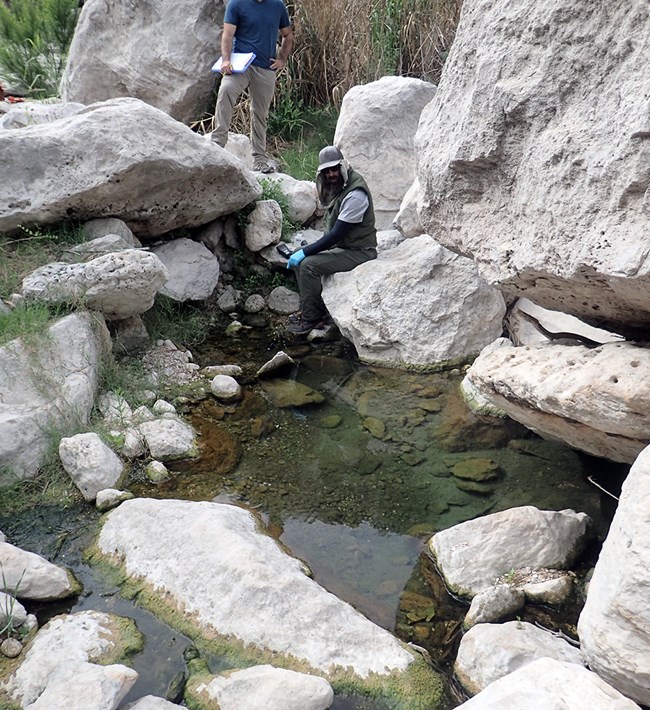
NPS
Recent Findings at Mouth of the Pecos
Mouth of the Pecos was last characterized in WY2018 and was classified as a limnocrene spring (emerges as one or more lentic pools). This spring was a complex of four potential orifices and the water present in April 2018 appeared to be dominated by spring discharge. The spring emerged as a series of pools and flowed into a marshy area. Water flowed from only one orifice into the first pool.
Site Condition
There was slight disturbance from roads/OHV trails and contemporary human. Disturbance from drying was high. Neither crayfish nor bullfrogs were observed.
The crew observed the following obligate/facultative wetland species/genera/families, all of which were also observed during the last visit in WY2019: cattail family (Typhaceae family), fogfruit (Phyla sp.), giant reed (Arundo sp.), mule-fat (Baccharis salicifolia), and willow (Salix sp.)
The crew observed the following invasive plants: giant reed (Arundo donax) in evenly distributed patches; Bermudagrass (Cynodon dactylon) in scattered patches; prickly lettuce (Lactuca serriola) in scattered patches; 1–5 plants of tree tobacco (Nicotiana glauca); and 1–5 plants of sowthistle (Sonchus sp.). This was the first observation of sowthistle at the spring since monitoring began in WY2017. The other species were observed at similar densities in prior years.

NPS
Water Quantity
The WY2021 visit occurred on April 14, 2021. Temperature sensors indicated that Mouth of the Pecos was wetted for 196 of 196 days (100%)—measured up to the WY2021 visit (Figure 8). However, these may be false-positive wetted days as the spring was dry during the WY2021 visit. In prior water years, the spring was also wetted 100% of the days measured. Discharge and wetted extent were not measured because the spring was dry. Tables 14 and 15 show ranges of values for discharge and wetted extent from prior years.
Water Quality
Water quality was not measured because the spring was dry. See Tables 16 and 17 for water quality value ranges from previous years.
Mouth of the Pecos Data Tables
| Sampling Location | Water Year 2021 |
Prior Water Years When Discharge Was Measured |
Range of Values From Prior Years |
|---|---|---|---|
| 006 | c.n.s. | 2019 | 23.1 (1) |
| Measurement | Water Year 2021 |
Prior Water Years When Springs Were Measured |
Range of Values From Prior Years |
|---|---|---|---|
| Width (cm) | c.n.s. | 2018–2019 | 379.3–417.3 (2) |
| Depth (cm) | c.n.s. | 2018–2019 | 43.7–45.0 (2) |
| Length (cm) | c.n.s. | 2018–2019 | 258.3–529.7 (2) |
| Sampling Location |
Width/Depth | Parameter | Water Year 2021 |
Prior Years When Sampling Occurred |
Range of Values From Prior Years |
|---|---|---|---|---|---|
| 005 | 25%/Center | Dissolved oxygen (mg/L) | c.n.s. | 2019 | 3.35 (1) |
| 50%/Center | Dissolved oxygen (mg/L) | c.n.s. | 2019 | 2.79 (1) | |
| 75%/Center | Dissolved oxygen (mg/L) | c.n.s. | 2019 | 3.50 (1) | |
| Center | Dissolved oxygen (mg/L) | c.n.s. | 2018 | 3.77 (1) | |
| 25%/Center | pH | c.n.s. | 2019 | 7.43 (1) | |
| 50%/Center | pH | c.n.s. | 2019 | 7.35 (1) | |
| 75%/Center | pH | c.n.s. | 2019 | 7.35 (1) | |
| Center | pH | c.n.s. | 2018 | 7.40 (1) | |
| 25%/Center | Specific conductivity (µS/cm) | c.n.s. | 2019 | 553 (1) | |
| 50%/Center | Specific conductivity (µS/cm) | c.n.s. | 2019 | 553 (1) | |
| 75%/Center | Specific conductivity (µS/cm) | c.n.s. | 2019 | 550 (1) | |
| Center | Specific conductivity (µS/cm) | c.n.s. | 2018 | 553 (1) | |
| 25%/Center | Temperature (°C) | c.n.s. | 2019 | 23.3–23.5 (2) | |
| 50%/Center | Temperature (°C) | c.n.s. | 2019 | 23.5–23.6 (2) | |
| 75%/Center | Temperature (°C) | c.n.s. | 2019 | 23.7 (2) | |
| Center | Temperature (°C) | c.n.s. | 2018 | 22.7–22.8 (2) | |
| 25%/Center | Total Dissolved Solids (mg/L) | c.n.s. | 2019 | 357.5 (1) | |
| 50%/Center | Total Dissolved Solids (mg/L) | c.n.s. | 2019 | 357.5 (1) | |
| 75%/Center | Total Dissolved Solids (mg/L) | c.n.s. | 2019 | 357.5 (1) | |
| Center | Total Dissolved Solids (mg/L) | c.n.s. | 2018 | 357.5 (1) |
| Sampling Location | Width/Depth | Parameter | Water Year 2021 |
Prior Years When Sampling Occurred |
Range of Values From Prior Years |
|---|---|---|---|---|---|
| 005 | Center | Alkalinity (CaCO3) | c.n.s. | 2018–2019 | 210–235 (3) |
| Center | Calcium (Ca) | c.n.s. | 2018–2019 | 54–60 (3) | |
| Center | Chloride (Cl) | c.n.s. | 2018–2019 | 15–24 (3) | |
| Center | Magnesium (Mg) | c.n.s. | 2018–2019 | 18–20 (3) | |
| Center | Potassium (K) | c.n.s. | 2018–2019 | 1.5–2.9 (3) | |
| Center | Sulphate (SO4) | c.n.s. | 2018–2019 | 29–34 (3) |
